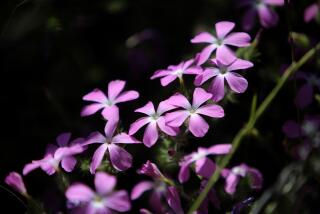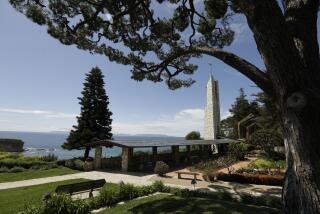In Plain View
- Share via
The Carrizo Plain isn’t for everyone. Achingly bare, its landscape is without the charm bracelet of undulating hills and swooping oak trees that decorate Cuyama to the south and San Luis Obispo to the west.
Yet seen from the air, the Carrizo Plain assumes a remarkable identity, as photographer Bill Dewey discovered 20 years ago while piloting his Cessna from Santa Barbara to Mariposa. What’s clear from above is the ripples and slashes and dents and lumps imprinted into the land by the monstrous San Andreas Fault, which is exposed along the Carrizo like nowhere else.
“What got me going on this project,” Dewey says of his years photographing the plain, “was not so much the obvious line of the fault, but its secondary effects. I’m not a geologist, and I don’t understand the dynamics of plate tectonics, but it’s as if a carpet was being pushed up against a wall and you see the resulting ridges and rolls.” The San Andreas Fault, he says, “is sort of the mother lode of our landscape.”
Because the fault continues to shift--and take the land with it--Dewey sees his pictures of the Carrizo Plain as a sort of stop-action photography, with the subject in the slowest possible motion. In his photographs the plain does seem alive, a giant asleep beneath a blanket that happens to be made up of wild grasses and flowers.
The arid Carrizo has long defied human habitation, although it is dotted with vestiges of aborted farming attempts from the late 19th and early 20th centuries, and some private ranches ring its edges. Fearing further encroachment, the federal government made the Carrizo Plain a National Monument in January 2001 to protect the threatened San Joaquin kit fox, the blunt-nosed leopard lizard, the San Joaquin antelope squirrel and the giant kangaroo rat that reside there. The monument’s 250,000 acres are also considered crucial for the California condor, sandhill crane and mountain plover, as well as Tule elk and pronghorn antelope, both of which were recently reintroduced to the plain.
Still, it’s not so much the bounty of living things that draws people to the Carrizo Plain as the lack of them, says Dewey, who specializes in aerial photography for government agencies and private developers when not working on his own projects from his Santa Barbara home. “One of the joys of the visitors center” at the monument, he says, “is that there are no visitors.”
Bill Dewey’s photographs of the Carrizo Plain are on exhibit at the Easton Gallery, 557 Hot Springs Road, Santa Barbara, (805) 969-5781, through March 21.
More to Read
Sign up for The Wild
We’ll help you find the best places to hike, bike and run, as well as the perfect silent spots for meditation and yoga.
You may occasionally receive promotional content from the Los Angeles Times.






